Other sources of Information—History of Cave Exploration—The formation of Caves—Exploration in Kent's Cavern—Evidence of two different races—The higher culture of the later race—Evidence of prolonged time—Exploration of Robin Hood Cave—Explorations in Valley of the River Meuse—M. Dupont's conclusions—Explorations in the Valley of the Dordogne—The Station at Schussenreid—Cavemen not found south of the Alps— Habitations of the Cave-men—Cave-men were Hunters—Methods of Cooking—Destitute of the Potter's art—Their Weapons—Clothing—Their skill in Drawing—Evidence of a Government—Of Religious belief—Race of the Cave-men—Distinct from the men of the Drift—Probable Connection with the Eskimos.
HAVE been delving, among the sands of ancient river bottoms for a proof of man's existence in far remote times. Slight and unsatisfactory as they may be to some, they are the materials with which we reconstruct a wondrous story of life and times removed from us by many a cycle of years.
Men have frequently resorted to the caverns of the earth for protection. In places we find caves that served this purpose during the Paleolithic Age. The men of the Drift, however, do not appear to have used them, save as temporary places of refuge, perhaps as a protection from bands of savage enemies, or from unusually inclement weather. But yet most surprising results have attended the exploration of caves in England, France, and Belgium. We find in those gloomy places that the men of the Drift were not the only tribes of men inhabiting Europe during the Glacial Age. In fact, living at later date than the Drift tribes, but still belonging to the Paleolithic Age, were tribes of people who appear to have utilized caverns and grottoes as places of permanent resort, and, judging from their remains, they had made considerable advance in the arts of living as compared with the tribes of the Drift.
But before pointing out the grounds upon which these conclusions rest, it may be well to give a slight review of the history of cave research. The dread and awe which kept people away from caves during the Middle Ages preserved their contents for later discoverers. In the seventeenth century, some adventurous spirits began to search in them for what they called Unicorn horns, which were deemed a most efficacious remedy for various diseases. This search served the good purpose of bringing to light various fossil bones of animals, and calling the attention of scientific men to the same.
The cave of Gailenreuth, in Bavaria, was explored by Dr. Goldfuss in 1810. He came to the conclusion that the bones of bears and other extinct animals were proofs of the former presence of the animals themselves. Dr. Buckland, a celebrated English writer, visited the cave in 1816, and became much interested in the work; so much so that when Kirkdale Cavern, in England, was discovered in 1821, he at once repaired to the spot and made a careful exploration. The results satisfied him that hyenas and other extinct animals had once lived in England. He followed up his explorations in a number of cases, and published a work on this subject in 1822, which marks the commencement of a new era in cave research.
In 1825 Kent's Cavern, near Torquay, was discovered, and Rev. J. McEnry made partial explorations in it. He discovered flint implements and perceived they might be a proof of the presence of man with these extinct animals. Dr. Buckland had not found these relics, or else had passed them by as of no importance, for he refused to entertain the theory that man and the extinct animals had been contemporaneous. Explorations made in France in 1827-8 had furnished such strong evidence on this point that it was deemed established by some scholars, but being opposed to the prevailing belief, nothing came of it.
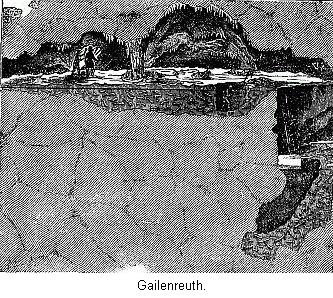
In 1829 Schmerling commenced his investigations in the caves of the valley of the Meuse. For years he continued his work under many difficulties. Sir Charles Lyell tells us he was let down day after day to the opening of the Engis Cave by a rope tied to a tree. Arriving there he crawled on all fours through a narrow passage way to the enlarged chamber, where, standing in mud and water, he superintended the investigations. He examined over forty of those caves, and published his results in 1833. He clearly showed that man must have been living along with various animals now extinct in Belgium. But, as before remarked, it was deemed sufficient answer to this careful explorer to point out that his results were opposed to the accepted chronology, and so they were passed by. When the time at last came, and their true worth was recognized, Schmerling himself had passed away.
We have already seen what great results followed the exploration of DePerthes in the river gravels. When it had been clearly established that man and extinct animals hid coexisted in Europe, the results of cave explorations were eagerly recalled, and governments vied with royal societies and private individuals in continuing the researches. The results are that a rich store of facts has been gathered from those gloomy resorts, illustrative of the later stages of Paleolithic art.
A word as to the formation of caves, grottoes, caverns, and rock shelters. These vary greatly in size, some being so small as to furnish protection to but few individuals; others, especially caves, so large that whole tribes might have found a place of resort within their chambers. They are found in all limestone countries. The formation of caves is now recognized as due to natural causes acting slowly through many years. Limestone rock is very hard and durable, but chemistry teaches us that water charged with carbonic acid gas will readily dissolve it. Rain-water falling from the clouds is sure to come in contact with masses of decaying vegetable matter, which we know is constantly giving off quantities of this gas. Laden with this the water sinks into the ground, and, if it comes in contact with limestone, readily washes some of it away in solution. But beds of limestone rock are noted for containing great fissures through which subterranean waters penetrate far into the ground. We can readily see how this percolating water would dissolve and wear away the surface of the rocks along such a fissure, and in process of time we would have the phenomenon of a stream of water flowing under ground.
Owing to a great many causes—such, for instance, as the meeting of another fissure—we would expect that portions of this underground way would become enlarged to spacious halls. In some such a way as this it is now understood that all caves have originated.
Owing to many natural causes the river may, after a while, cease to flow, leaving enlarged portions of its channel behind as a succession of chambers in a cave. But water would still come trickling in from the tops and sides, and be continuously dripping to the floor, where it speedily evaporates. When such is the case it leaves behind it the limestone it held in solution. So, in process of time, if the deposition is undisturbed, there will be formed over the floor of the cave a more or less continuous layer of limestone matter known as stalagmite. The same formations on the top and sides of the cave are called stalactites. In places where the drip is continuous the stalactite gradually assumes the shape of an immense icicle; while the stalagmite on the floor of the cave, underneath the drip, rises in a columnar mass to meet the descending stalactite. A union of these is not uncommon, and, we have pillars and columns presenting the strange, fantastic appearance on which tourists delight to dwell in their notes of travel.
While these accumulations are in all cases very slow, still we can not measure the time since it commenced by the rate of present growth, because this rate varies greatly at different times and places even in the same cave. And we must also remark that this complete series of changes only occur in a few localities, the majority of caves being insignificant in size.2
From what has been said as to the formation of caves, we would expect them to occur in river valleys, and this is the case, though in some instances there have been such immense changes in the surface level of the country that we can now find no trace of rivers near them. This is exactly similar to some gravel deposits, which, as we have seen, are occasionally found where is now no running water. The most noted caverns, however, are found high up on the banks of existing rivers. We can not doubt that the rivers were the cause of the caves. But having excavated their beds below the level of the then existing caves, they ceased to flow in them, and left them to be occupied by savage animals and the scarcely less savage men. But at times, swollen by floods, the river would again assert its supremacy and roll its waters through its old channels.
These floods would not only tear up and rearrange whatever débris had already accumulated, but would introduce quantities of sediment and animal remains. In some such a manner as is here pointed out (though exactly how geologists are not agreed) caves were invaded, after being long occupied by men or animals, by floods of water. In many cases the evidence would seem to indicate that after such a visitation by water the cave and its water-rolled and water-arranged contents were left to silence, visited by neither man nor beast. In such instances stalagmitic coverings would gradually form over the confused débris, and in some places acquire a thickness of several feet. In some instances several such floors are found one above the other, pointing to a prolonged period of usage, and then a quiet stage, in which the drip of falling water alone broke the silence, and nature sealed up another chapter of cave biography beneath the layer of stalagmite.
One of the most important caves of England is Kent's Cavern, before mentioned. This cave was carefully explored under the direction of a committee appointed by the British Association, and to show the care and thoroughness of the work we need only state that this work occupied the greater portion of sixteen years, and hence the results obtained may be regarded as, in a general way, illustrative of the life of the cave dwellers. "This cave is about a mile east of Torquay harbor, and is of a sinuous character, running deeply into a hill of Devonian limestone, about half a mile distant from the sea. In places it expands into large chambers, to which various distinctive names have been given."3
Let us see what general results have been reached by this committee. The investigation disclosed several different beds of stalagmite, cave earth, and breccia. The lowest layer is a breccia.4 The matrix is sand of a reddish color, containing many pieces of rock known as red-grit and some pieces of quartz. This implies the presence of running water, which at times washed in pieces of red-grit. The surface features must have been quite different from the present, since now this rock does not form any part of the hill into which this cave opens.5And this change in drainage took place before this lowest layer was completed, since not only bears, but men, commenced to visit the cave. The presence of bears is shown by numerous bones, and that of man by his implements.
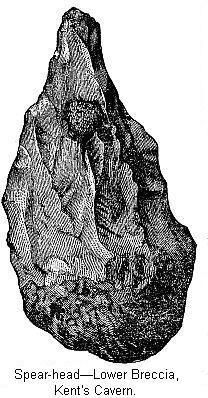
We must notice that all the implements found in the breccia are similar to those of the Drift, being rudely formed and massive. No doubt these are the remains of Drift men, who, for some cause or other, temporarily visited the cave, perhaps contending with the cave bear for its possession. But a time at length arrived when for some reason neither animals nor man visited the cave. The slow accumulation of stalagmite went forward until in some places it had obtained a thickness of twelve feet. Freely admitting that we can not determine the length of time demanded for this deposition, yet none can doubt that it requires a very long time indeed. Says Mr. Geikie: "How many centuries rolled past while that old pavement was slowly accreting, no one can say; but that it represents a lapse of ages compared to which the time embraced by all tradition and written history is but as a few months, who that is competent to form an opinion can doubt?" But after this long period of quiet, from some source great torrents of water came rolling through the cave. We know this to be so, because in places it broke up this layer of stalagmite and washed it away, as well as large portions of the breccia below, and after the floods had ceased, occasionally inundations still threw down layers of mud and silt. This accumulation is known as cave earth, and is the layer containing the numerous remains of the Cave-men. Here the explorers were not only struck with the large number of implements, but at once noticed that they were of a higher form and better made. Instead of the rude and massive implements of the Drift tribes, we have more delicate forms chipped all around. And we also meet with those that from their form may have been used as the heads of spears or arrows. Flakes were also utilized for various purposes. We also find implements, weapons, and ornaments of bone—a step in advance of Drift culture. They had "harpoons for spearing fish, eyed needles or bodkins for stitching skins together, awls perhaps to facilitate the passage of the slender needle through the tough, thick hides; pins for fastening the skins they wore, and perforated badgers' teeth for necklaces or bracelets."6 Nothing of this kind has yet been shown as belonging to the men of the Drift.
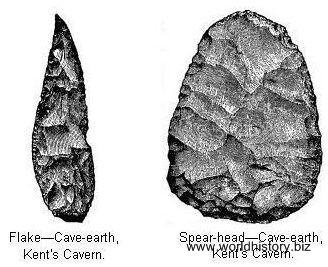
The bones of a large number of animals are also found in the cave earth. The most abundant is the hyena, and no doubt they dragged in a great many others; but the agency of man is equally apparent, as the bones have often been split for the extraction of marrow. Besides bones of the hyena, we have also those of the lion, tiger, bear, and reindeer.7
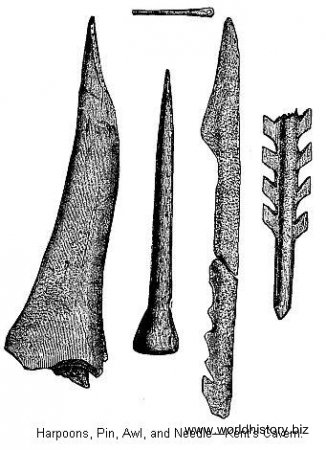
With these animals man, from time to time, disputed possession of the cave. At one place on the surface of the cave earth is found what is known as the "black band." This is nothing more or less than the fire-place of these old tribes. Here we find fragments of partially consumed wood, bones showing the action of fire—in short, every thing indicating a prolonged occupancy by man.
No one can doubt but that this deposit of cave earth itself requires a prolonged time for its accumulation.8 But this period, however prolonged, at length comes to an end. From some cause, both animals and man again abandoned the cave. Another vast cycle of years rolls away—a time expressed in thousands of years—during which nature again spread over the entombed remains a layer of stalagmite, in some places equal in thickness to the first formation. Above this layer we come to a bed of mold containing remains of the later Stone Age, of the Bronze, and even of the Iron Age. Below the first layer of stalagmite—the completed biography of Paleolithic times; above, the unfinished book of the present. Such are the eloquent results obtained by the thorough exploration of one cave. The results of all the other explorations, in a general way, confirm these. Mr. Dawkins explored a group of caverns in Derbyshire, England. These caverns and fissures are situated in what is known as Cresswell Crags, the precipitous sides of a ravine through which flows a stream of water dividing the counties of Derby and Nottingham.
This cut represents the different strata in Robin Hood cave. It will be seen that, at one place, the stalactite has united with the stalagmite below. It is not necessary to go into the details of this exploration. All the relics of man found in d, c, and the lower portions of b, are the rude and massive forms peculiar to the River Drift tribes. But the relics found in the breccia a, and the upper portion of the cave earth b, denote a sudden advance in culture. The rude tools of the lower strata are replaced by more highly finished ones of flint.
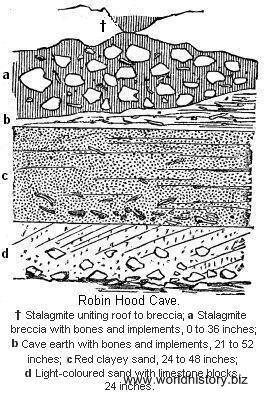
The most important discovery was that of a small fragment of rib, with its polished surface ornamented with the incised figure of a horse. The peculiar value of this discovery is, that it serves to connect the Cave-men of England with those of the continent who, as we shall afterward see, excelled in artistic work of this kind.
In another cave of this series, in association with similar flints, were found the following bone implements. We can only conjecture the use of the notched bone. The pieces of reindeer horn, terminating in a scoop, may have served as a spoon to extract marrow.
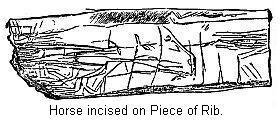
We must not fail to notice that the more highly finished relics of the Cave-men are found in strata overlying those of the River Drift; and, in the case of Kent's Cavern, these two sets of implements are separated by a layer of stalagmite requiring a very prolonged time for its formation. This would imply that the Cave-men came into England long after the tribes of the River Drift; and, judging from the relics themselves, they must have been a distinct people. We must recall how completely the climate and animals in England varied during the Glacial Age. We have also seen how closely connected the River Drift tribes were with the animals of the warm temperate regions. Coming at a later date, totally distinct from them in culture are those Cave-men—perhaps they may prove to be associated with the Arctic animals. But, before speculating on this point, we must learn the results attending the exploration of the caves of Belgium, France, and other countries on the continent of Europe.
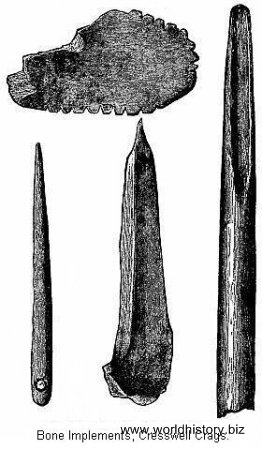
In the valley of the river Meuse (Belgium), and its tributaries, have been found a number of caves and rock-shelters. It was in the caves of the Meuse that Schmerling made his explorations. When the real value of his work was recognized, the Belgian government had a thorough exploration made by M. Dupont, director of the Royal Museum in Brussels. This gentleman scientifically examined forty-three of these resorts. His opinions, therefore, are deserving of great weight; but, unfortunately, they are not accepted by all. These caves vary greatly in size—many being mere rock-shelters. From their position, we are at once struck with the prolonged period of time necessary to explain their formation. They are found at very different heights along the river's bank. In one case two caves are so situated that the river must have sunk its bed nearly two hundred feet between the time of their formation.9
M. Dupont thinks the evidence very clearly points to the presence of two distinct stages in cave life—one of which he calls the Mammoth period, and the other, which is more recent, the Reindeer. It is, however, known that the mammoth lived all through the Reindeer epoch, if not to later times; so the names bestowed on these periods do not seem very appropriate. We can readily see, however, that, while the names might be wrong, the two periods might be reality. In many cases, the same cave contained remains of both stages, separated by layers of cave earth, and it is noticed that, in such cases, those of the Reindeer stage are invariably of a later date. In general terms, M. Dupont finds that the implements of the Mammoth period are of a rude make, consisting of a poor kind of flint, and poorly finished. But, in beds of the Reindeer epoch, the flint implements consist, principally, of well-shaped blades and flakes—with numerous bodkins, or awls—javelins, or arrow-heads —besides articles of bone and horn such as harpoons, and teeth of various animals drilled as if suspended for ornaments. Their workmanship indicates decidedly more skill than that of the implements obtained from the lower levels. But the most remarkable finds of the Reindeer epoch consist of portions of reindeer horn, showing etchings or engravings which have been traced by some sharp point, no doubt by a flint implement. One small bit of horn has been cut or scraped so as to present the rude outline of a human figure.
So far the evidence seems to bear out the same conclusions as do those of the British caves, though it also shows that the men of the Drift inhabited caves quite extensively. We must remember, however, that the greatest wealth of cave relics belongs to the so-called Cave-men, but that savage tribes have always resorted to caves as a place for occasional habitation.10
It is in France that we find the greatest wealth of relics of Cave-men. Sir John Lubbock has left us a description of the valley of the Vezère, where these caverns occur. The Vezère is a small tributary of the Dordogne. "The rivers of the Dordogne run in deep valleys cut through calcareous strata: and while the sides of the valley in chalk districts are generally sloping, in this case, owing probably to the hardness of the rock, they are frequently vertical. Small caves and grottoes frequently occur: besides which, as the different strata possess unequal power of resistance against atmospheric influence, the face of the rock is, as it were, scooped out in many places, and thus 'rock- shelters' are produced. In very ancient times these caves and rock-shelters were inhabited by men, who have left behind them abundant evidence of their presence.
"But as civilization advanced, man, no longer content with the natural but inconvenient abode thus offered to him, excavated chambers for himself, and in places the whole face of the rock is honey-combed with doors and windows, leading into suits of rooms, often in tiers one over the other, so as to suggest the idea of a French Petra. Down to a comparatively recent period, as, for instance, in the troublous times of the Middle Ages, many of these, no doubt, served as very efficient fortifications, and even now some of them are in use as store- houses, and for other purposes, as, for instance, at Brantome, where there is an old chapel cut in solid rock.
"Apart from the scientific interest, it was impossible not to enjoy the beauty of the scene which passed before our eyes, as we dropped down the Vezère. As the river visited sometimes one side of the valley, sometimes the other, so we had at one moment rich meadow lands on each side, or found ourselves close to the perpendicular and almost overhanging cliff. Here and there we came upon some picturesque old castle, and though the trees were not in full leaf, the rocks were, in many places, green with box and ivy and evergreen oak, which harmonized well with the rich yellow brown of the stone itself."11
Thus it will be seen this valley has been a favorite resort for people at widely different times, and amongst others, the cave dwellers of the Paleolithic Age. As in the caves of Belgium, some of them are at a considerable height above the stream, while others are but little above the present flood line. Mr. Dawkins refers us to the results of the exploration of a French scientist in one of the grottoes of this section, which seem to be exactly similar to the results obtained from the caves of Cresswell Crags and Kent's Cavern. The implements obtained from the two lower strata are rough choppers and rude flakes of jasper and other simple forms. Above these beds was a stratum of black earth, underneath a sheet of stalagmite. Here were found implements of a far higher type: those of flints, consisting of flakes, saws, and scrapers, with finely chipped heads and arrow-heads, and awls and arrow-heads of bone and antler.12 Now these results can only be interpreted as were those in the English caverns. The lower and ruder implements belong to the men of the Drift; the later and more polished ones to the Cave-men.
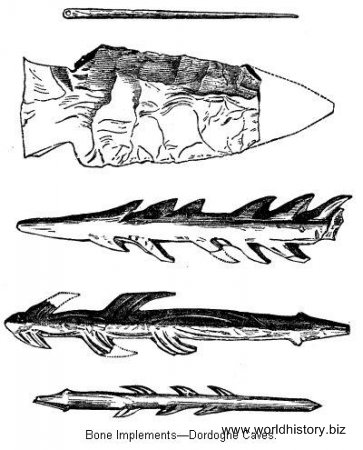
Most of the relics obtained from these caverns belong to the Cave-men proper. However, the implements from one of them, known as Le Moustier, are of a rude type, and may belong to those of the Drift. But most of them are of superior make and finish. These specimens are all from caves in this vicinity.13
We have seen that the men of the Drift were very widely scattered over the earth. We find, however, that the Cave-men had a much more limited range. Dr. Fraas has shown their presence in Germany. At Schussenreid, in Bavaria, was found an open air station of these people. It was evidently a camping- ground, one of the few places where proofs of their presence have been discovered outside of caves. Here we found the usual débris, consisting of broken bones, charcoal, blackened hearth-stone, and implements of flint and horn. We must stop a minute to notice a bit of unexpected proof as to the severity of climate then prevailing in Europe. This deposit was covered up with sand, and on this sand were the remains of moss, sufficiently perfect to determine the kind. We are assured that it is composed of species now found only in Alpine regions, near or above the snow-line, and in such northern countries as Greenland and Spitzbergen.14 Dr. Fraas also proved their presence in several caves in Suabia. One known as the Hohlefels Cave was very rich in these relics. They have been found in Switzerland, as at Thayengen; but are not found south of the Alps or the Pyrenees. Men, indeed, inhabited caves in Italy, but they did not use the implements characteristic of the Cave-men.15 Mr. Dawkins points out that this range corresponds very nearly to that of the northern group of animals, thus differing widely from the men of the River Drift. In this connection we must notice that the reindeer is the animal whose remains are most commonly met with in the débris they have left in the caves. This animal surely testifies to a cold climate. We are thus justified in concluding that the Cave-men are associated with the Arctic group of animals.16
We must now turn our attention to the culture of the Cave-men. We must reflect that long ages, with great changes of climate and life, both animal and vegetable, have rolled away since the remains of these early races were sealed by the stalagmite formation in caves. The relics at their best are but scanty memorials of a people long since passed, and we can not expect, can not hope, to recover more than a general outline. But this will be found full of interest, for it is a picture of Paleolithic life and times existing in Europe long ages before the pyramids of Egypt were uplifted.
With respect to habitations, we have already seen that he took up his abode in caves, at least where they were suitable. According to their depth and the light penetrating them, he either occupied the whole extent of them, or established himself in the outlet only. About the center of the cave some slabs of stone, selected from the hardest rock such as sandstone or slate, were bedded down in the ground, and formed the hearth for cooking his food. But in no country are such resorts sufficiently numerous to shelter a large population; besides, they, are generally at some distance from the fertile plains, where game would be most abundant. In such cases they doubtless constructed rude huts of boughs, skins, or other materials. Such an out-door settlement was the station at Solutré, France, where has been found an immense number of bones of horses, reindeers, also, though in less abundance, those of elephants, aurochs, and great lions.17
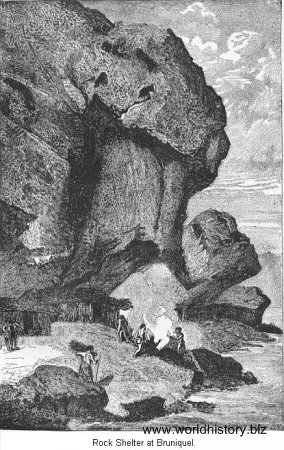
Where no cave presented itself, these people made for themselves convenient sheltering places under the cover of some great overhanging rock. In various places in France such resorts have been discovered. The name of "rock shelters" has been given to such resorts. In such places, where we may suppose they built rude huts, are found rich deposits of the bones of mammals, birds, and fishes, as well implements of bone and horn.
We have frequently referred to the presence of hearths, showing that they used fire. Like other rude races, it is probable that they obtained fire by the friction of one piece of wood upon another. M. Dupont found in one of the Belgium caves a piece of iron pyrites, from which, with a flint, sparks could be struck.
Speculations have been indulged as to the probable condition of man before he obtained a knowledge of fire. If the acquisition of fire be regarded as one of the results of human endeavor, it must surely be classed as one of the most valuable discoveries which mankind has made. We do not believe, however, that we shall ever discover relics of races or tribes of men so low in the scale as to be ignorant of the use of fire. Even some of the flints which M. Bourgeois would refer to the Miocene Age show evidence of its action.18
The men of the Caves supported life by hunting. But a very small part of their food supplies could have been drawn from the vegetable kingdom. When the climate was so severe that Alpine mosses grew at Schussenreid, acorns and like nuts would be about all they could procure from that source. The animals hunted by the Cave-men were principally reindeer, horses, bisons, and, occasionally mammoths and woolly rhinoceros. But they were not very choice in this matter, as they readily accepted as food any animal they could obtain by force or cunning. Wolves and foxes were not rejected, and in one cave large numbers of the bones of the common water rat were obtained. We know what animals were used as food, because we find their bones split for the purpose of procuring the marrow they contained. This was evidently to them a nutritious article of diet, since they were careful to open all the bones containing it, and bones so split are frequently the only means of detecting the former presence of man in some bone caves.
We must not forget that at that time the shore of the Atlantic Ocean, during a large part of the Paleolithic Age, was situated much farther west than it is now, and so in all probability many refuse heaps are now underneath the waves. From certain drawings that are found in some French caves, we know they were used for hunting both seals and whales.
We can not doubt that the capture of a whale afforded as much enjoyment to them as it does to a tribe of Eskimos now. Bones of birds and fishes are found in many instances. The salmon appears to have been a favorite among fishes. Among the birds are found some species now only living in cold countries, such as the snowy owl, willow grouse, and flamingo. This is but another proof that the climate of Europe was then very cold.
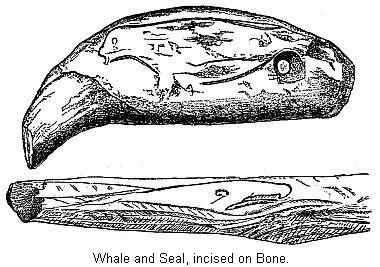
The Cave-men were not afraid to attack animals greatly superior to them in strength. In the Hohlefels Cave in Germany were found great quantities of the broken and split bones of cave bears, an animal very similar to the grizzly, and probably its equal in strength. The reindeer was the main reliance of these tribes. Its bones are found in great abundance, and it doubtless was to them all it is to the Lapps of Europe to-day, except, of course, that it was not domesticated.
Though fire would naturally suggest some rude method of cooking, we can scarcely find a trace of such operations, and it has been a matter of conjecture how they proceeded. Sir John Lubbock thinks they boiled their food, and in the absence of pottery used wooden or skin vessels, bringing the water to a boiling point by means of stones heated red hot and thrown into the water. He points out the presence of peculiarly shaped stones found in some caves, which he thinks were used for this purpose.19 It is not supposed they had any articles of pottery during this epoch. This is quite an important point, because a knowledge of pottery marks an important epoch in the culture of a people.
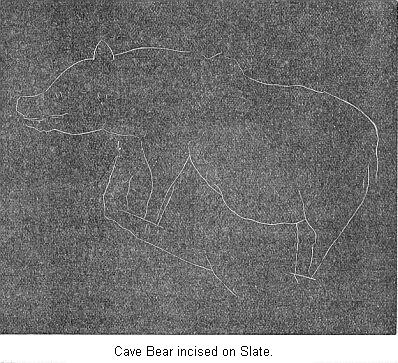
A people possessed of this knowledge have passed from Savagism into the lower status of Barbarism.20 A piece of pottery is as little liable to destruction as a piece of bone, and so, had those people possessed pottery, there is no reason why pieces of it should not be found in every refuse heap, and amongst the débris of all caves. But such is not the case; no fragments of pottery have yet been found which can be referred with confidence to the epoch of the Cave-men.21
Some speculations have been indulged in as to whether the men of this age were cannibals or not. It need occasion no surprise if they were, since ancient writers assert that even during historical times this practice prevailed in Europe.22 Though not definitely proven there are many facts difficult of explanation, except on this supposition. However, it may well be that this, after all, only amounted to the custom of eating parts of an enemy killed in battle, as certain modern savages do that we would not call cannibals.23
It is not necessary to speak at much length of the methods of hunting. They had bows and arrows, daggers of reindeer horn, spears tipped with flint or bone, and harpoons. Besides, they made a formidable club of the lower jaw-bone of the cave-bear with its canine tooth still left in its place. Fishing with nets is not supposed to have been known, Harpooning was probably their favorite way. M. G. DeMortillet thinks they fished as follows: They fastened a cord to the middle of a small splinter of bone. This was then baited, and when swallowed by the fish, was very certain to get caught in the body.24
We know that rude tribes of to-day have many means of snaring animals. Doubtless similar scenes were enacted on their primeval hunting-grounds. French books contain illustrations of the men of this period driving game over precipitous sides. They had no dogs to assist them in the hunt, and though reindeer were around them in great abundance, it is not supposed that they thought of domesticating them.
Man is the only animal which seeks to protect his body from the Summer's heat or the cold of Winter by the use of clothing. We are, unfortunately, not able to present many details of the dress of man during the early Stone Age. We are, however, quite certain that when the climate was severe enough to permit such animals as the musk-sheep and the reindeer to inhabit South- western Europe, man must have been provided with an abundance of warm clothing, though doubtless rudely made and fashioned. Many reindeer horns found in France are cut and hacked at the base in such a way as to indicate that it was done when removing the skins. We also know that the rudest of savage tribes are never at a loss for some process of tanning hides and rendering them fit for use. From the immense number and variety of scrapers found among the cave débris. we are sure the preparation of clothing occupied no inconsiderable portion of their time. We also find numerous awls and splinters of flint and bone, which they doubtless used in exactly the same manner as similar tools are used by the Lapps to-day in Europe, that is, to pierce holes in the hides, through which to pass their rude needle and thread. The needles are made of reindeer horn, and they were not only smoothly polished, but the eyes are of such a minute size, and withal so regularly made, that many at first could not believe they were drilled by the use of flint alone. This, however, has been shown to be the case by actual experiments. The thread employed was reindeer tendons, for bones of these animals are found cut just where they would he cut in removing these tendons. This cut shows that they protected their hands by means of long gloves of three or four fingers.25
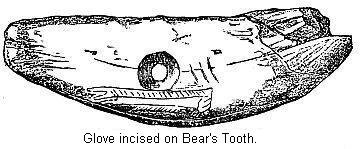
We have thus far been considering those arts which pertain more directly to living. We have presented some sketches found engraved on pieces of bone. We first noticed this among the relics found in one of the Creswell caves in England. It was also noticed in Belgium. It was among the Cave-men of Southern France that this artistic trait became highly developed. Among the reindeer hunters of the Dordogne were artists of no mean ability. We must pause a minute and mark the bearing of this taste for art. We have seen many reasons for supposing the men of the caves much farther advanced in the scale of culture than those of the Drift, but we have also seen that we can not rank them higher than the highest grade of savages.
Sir John Lubbock thus speaks of them: "In considering the probable condition of these ancient Cave-men, we must give them full credit for their love of art, such as it was; while, on the other hand, the want of metal, of polished flint implements, and even of pottery, the ignorance of agriculture, and the apparent absence of all domestic animals, including even the dog, certainly imply a very low state of civilization."26
They were certainly not as far advanced in civilization as the next race we will describe, yet the Neolithic people had no such skill as was possessed by the cave-men. This need not surprise us, because "an artistic feeling is not always the offspring of civilization, it is rather a gift of nature. It may manifest its existence in the most barbarous ages, and may make its influence more deeply felt in nations which are behind in respect to general progress than in others which are more deeply advanced in civilization."27
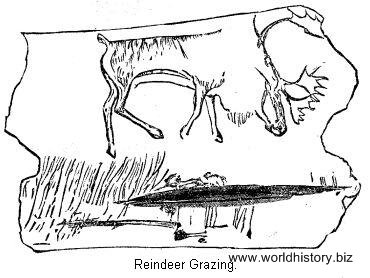
In regard to the objects themselves, a glance at the illustrations show us that they are quite faithful sketches of the animals at that time common. As might be expected, sketches of the reindeer are numerous. This cut is regarded as the highest example of Paleolithic art, sketched on a piece of horn and found in Switzerland. The animal is grazing, and the grass on which it feeds is seen below. We have on a piece of slate the outlines of a group of reindeer, generally considered as representing a fight, though it may mean a hunt, and that the hunter has succeeded in killing a portion of the herd. Some, as we see, are on the ground.
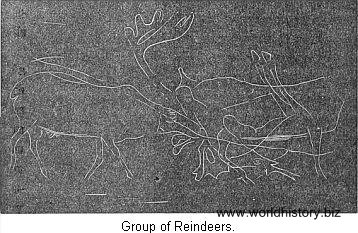
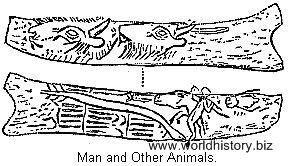
It would be exceedingly interesting could we but find well executed sketches of the men of this period, but, unfortunately, with one or two exceptions, no representations, however rude, have yet been discovered of the human form. Perhaps an explanation of this fact may be found in the well-known reluctance of savage tribes to have any engravings taken of themselves, and we can well imagine that if any one was known to make drawings of human beings he would be regarded with suspicious distrust, and it would hardly be a safe accomplishment to possess. One very curious group represents a man, long and lean, standing between two horses' heads, and by the side of a long serpent or fish, having the appearance of an eel. On the reverse side of this piece of horn were represented the heads of two aurochs or bisons. Mr. Dawkins thinks this also represents a hunting sketch, and that the man is in the act of striking one of the horses with a spear.
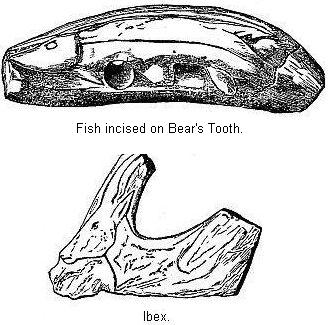
On, a fragment of spear-head found in France several human hands were engraved, but having only four fingers each. On this point Mr. Lartet assures us that some savage tribes still depict the hand without the thumb.28 Representations of birds and reptiles are very rare; fishes are more common. On a piece of reindeer's horn was found this representation of the head and chest of an ibex. Of special interest to us is a representation of a mammoth found engraved on a piece of mammoth tusk in one of the Dordogne caves. We have no doubt that the artist who engraved it was perfectly familiar with the animal itself.
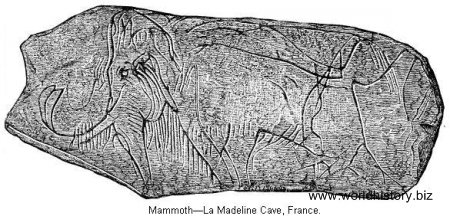
Their artistic skill was not confined to the execution of drawings. They frequently carved pieces of reindeer horn into various animal forms. Our next cut shows us a dagger, the handle of which is carved to imitate a reindeer. It will be seen how the artist has adapted the position of the animal to the necessities of the case. Flowers are very seldom represented; but one implement from France has a very nice representation of some flowering plant engraved on it.
Take it all in all, the possession of this artistic instinct is certainly remarkable—the more so when we remember the rudeness of his surroundings, and the few and simple means at his command for work. "A splinter of flint was his sole graving tool; a piece of reindeer horn, or a flake of slate or ivory, was the only plate on which primitive man could stamp his reproduction of animated nature."29
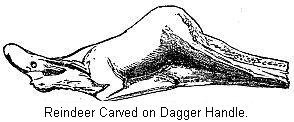
Some speculations have been indulged in as to whether we have any traces of a government amongst the Paleolithic people. That they had some chief or leader is more than probable. In the caves of France we find a number of fragments of reindeer horn. Generally speaking, they show evidence of a good deal of care in making them. They are carved and ornamented with sketches of various animals, and invariably have one or more holes bored in the base. The idea has been quite freely advanced, that these are emblems of authority.30 And some have pointed out, that, though they are too light for use as weapons, yet, their "frequent occurrence, and uniformity of type, show that they possess a conventional significance."31 Mr. Geikie says that these conjectures "are mere guess-work."32 And Mr. Dawkins points out that they are very similar in design and ornament with an implement of the Eskimos known as an "arrow-straightener."33
Whatever may be our conclusions in regard to these ornamented pieces of reindeer horn, we can not doubt but that their social instincts found expression in some sort of alliance for the common good. This is shown by several facts: such, for instance, as the evidence of trade or barter between localities considerable distances apart. The inhabitants of Belgium must have gone to what is now Southern France to procure the flint they used. They also procured, from the same source, fossil sea- shells, which they valued highly.34 We also notice the fact, that certain localities appear to have been used as the place of manufacture for certain articles, to the exclusion of others. In other words, the primitive people appear to have learned the great utility of a division of labor. One of the caves in Belgium appears to have been used as a place to make flint implements. Over twenty thousand articles of flint were found in this cave.35 In France, while in one cave the implements were all of the spear-head type, in a neighboring cave horn was almost the only article used in the manufacture of implements. We must not, however, form an exalted idea of their trade—it was simply barter in a rude state of society.36


Various opinions have been held as to whether we have any trace of a religious belief. Theoretically speaking, they had some sort of a religion, though doubtless very vague and indistinct; for we know of no nation as far advanced as they were destitute of it.37 It has been pointed out, that the bones of some animals, as the horse, were very rare, and their absence explained as the result of superstitious reasons. It has also been conjectured that some of the perforated bones and teeth of animals found in various deposits were amulets worn for religious purposes; and some have gone so far as to infer, that the ornamentations on some of these so-called amulets represent the sun, and that, consequently, sun-worship prevailed among the Cave-men. While these various conjectures are, of course, possible, it is equally certain they are all "mere guess-work."
Early explorers describe with considerable degree of confidence the manner of burial among the Cave-men, and inferred from the remains found buried with the bodies that they had some notion of a life beyond the grave—and, accordingly, placed near the body food and drink to support him on his journey, weapons wherewith to defend himself, and his favorite implements, so that, arrived at the land of spirits, he would be well provided for. These result are not borne out by later investigations. The instance mentioned most prominently, that of the burial cave at Aurignac, France, has been shown to have no bearing on the question, as every thing indicates that the burials were of a much later date.
We have yet a most important question before us—one that is still engaging the attention of scientific men in Europe. That is the question of race. Who were these early tribes? Are they in any way connected with the men of the Drift? Have we any representations of them now living upon the earth? On these questions there is quite a diversity of opinion. In various caves in France and Belgium, skulls and other bones of the human skeleton have been found. These have been studied with care by the best scholars in Europe; and B. Carfares has set forth the results in his various works, in which he connects them, not only with the men of the River Drift, but with the race of men that inhabited Europe during the succeeding Neolithic Age, and, indeed, with men now living in France and Belgium.
There is no question as to the correctness of these inferences —the only one is, whether the skulls and fragmentary skeletons are really remains of the Cave-men. This must be made perfectly clear and unquestioned before we are to accept them. Mr. Darkens reviews the various cases where skeletons have been found in caves.38 He points out that, in every instance, very serious doubts can be raised as to whether they are really remains of the Cave-men or not.
Until these objections are met, we do not see how the opinion of B. Carfares (above) can be accepted. But if these instances are not accepted, then, in all other instances where there is no doubt, the remains are in such a fragmentary condition that no conclusion can be made from them. So as far as remains of the human skeleton are concerned, we can form no conclusions as to the race to which the Cave-men belonged.
We have already noted, that the Cave-men came into Europe much later than the men of the Drift, and that their range was very limited, corresponding, in fact, with that of the northern group of animals. When the cold of the Glacial Age passed away, the musk-sheep, reindeer, and other animals, were driven out of Europe. They are found now only in high northern latitudes, such as Greenland. Mr. Darkens thinks that there, also, are to be found the Cave-men of the Paleolithic Age, now known as the Eskimos. Though not accepted by all authorities, yet some of our best scholars find much to commend in this theory.
We have undoubted proofs that, in America, the Eskimos formerly lived much farther south.39 And Dr. Abbot thinks the Paleolithic implements discovered in New Jersey, bearing such striking resemblance to those of Europe, are undoubtedly their work.40 Therefore, there is no absurdity in asserting that they once lived in Western Europe; the more so, when we reflect that the climate, the animals—in fact, all their surroundings— must have been similar to those of their present habitats.
When we come to examine the customs and habits of these Eskimos, we are at once struck with their resemblance to what we have seen was the probable state of life among the Cave-men. At Solute, for instance, we have vast refuse heaps of bones of animals. We find similar heaps around the rude huts of the Eskimos to-day. Captain Parry describes one as follows: "In every direction round the huts were lying innumerable bones of walruses and seals, together with skulls of dogs, bears, and foxes."41
Other points of comparison strike us when reading Sir John Lubbock's account of their habits and customs. For instance: "Their food, if cooked at all, is broiled or boiled; their vessels, being of stone or wood, can not, indeed, be put on the fires, but heated stones are thrown in until the water becomes hot enough and the food is cooked." "Their food consists principally of reindeer, musk-ox, walrus, seals, birds, and salmon. They will, however, eat any kind of animal food. They are very fond of fat and marrow, to get at which they pound the bones with a stone." "The clothes of the Eskimos are made from the skins of the reindeer, seals, and birds, sewn together with sinews. For needles they use the bones of either birds or fishes." "The Eskimos have also a great natural ability for drawing. In many cases they have made rude maps for our officers, which have turned out to be substantially correct. Many of their bone implements are covered with sketches."

In this cut we have a bone drill on which are sketched reindeer, geese, a braider or flat-bottomed boat, a tent around which various articles of clothing are hung up to dry, a woman apparently engaged in the preparation of food, and a hunting scene.
Now, we know that savage tribes, widely separated by time and space, will, after all, under the pressure of common necessities, invent much the same implements and live much the same life. But still, where every thing seems to coincide, the climate, the animals, the mode of life proved the same, and especially when both are seen possessed of a common artistic skill, together with the known fact that in the Western Continent the Eskimos did formerly live much farther south; there is surely a strong case made out, and therefore the probabilities are that the Eskimos are the representatives of the Cave-men of Europe.42 And yet we must be cautious on this point; or rather we remember that the phrase, "predecessors of the Eskimos," does not imply that they were in all respects like them. An examination of the rude sketches of the Cave-men left by themselves seems to indicate that the whole body was covered with hair. "The hunter in the Antler from Duluth Cave has a long, pointed beard, and a high crest of hair on the poll utterly unlike the Eskimo type. The figures are also those of a slim and long-jointed man."43
This completes our review of the Paleolithic people, and it only remains to present some general conclusions. The Glacial or Pleistocene Age is seen to have been of immense duration, and characterized by great changes in climate. We have found that two races of men occupied Europe during this time. The men of the River Drift are the most ancient.
We have seen that they can be traced over wide-extended areas. They seem to have invaded Europe, along with the great invasion of animals from Asia, constituting the temperate group of animals; and with those animals they probably shifted back and forth, as the cold of the Glacial Age increased or waned. These people seem to have completely vanished. At a later date, when the cold of the Glacial Age was once more severe, associated with animals now living only in high northern latitudes, came the Cave-men, whose discussion has formed the subject of this chapter.
It will be seen how much we owe to patient investigators. The results are, indeed, bewildering. They make us acquainted with a people the very existence of whom was not known a few years back. Though the whole life of those ancient races seemed hopelessly lost in the night of time, the gloom is irradiated by the light of modern science, which lays before our astonished vision the remains of arts and industries of the primitive tribes that occupied Europe during the morning-time of human life.
REFERENCES
HAVE been delving, among the sands of ancient river bottoms for a proof of man's existence in far remote times. Slight and unsatisfactory as they may be to some, they are the materials with which we reconstruct a wondrous story of life and times removed from us by many a cycle of years.
Men have frequently resorted to the caverns of the earth for protection. In places we find caves that served this purpose during the Paleolithic Age. The men of the Drift, however, do not appear to have used them, save as temporary places of refuge, perhaps as a protection from bands of savage enemies, or from unusually inclement weather. But yet most surprising results have attended the exploration of caves in England, France, and Belgium. We find in those gloomy places that the men of the Drift were not the only tribes of men inhabiting Europe during the Glacial Age. In fact, living at later date than the Drift tribes, but still belonging to the Paleolithic Age, were tribes of people who appear to have utilized caverns and grottoes as places of permanent resort, and, judging from their remains, they had made considerable advance in the arts of living as compared with the tribes of the Drift.
But before pointing out the grounds upon which these conclusions rest, it may be well to give a slight review of the history of cave research. The dread and awe which kept people away from caves during the Middle Ages preserved their contents for later discoverers. In the seventeenth century, some adventurous spirits began to search in them for what they called Unicorn horns, which were deemed a most efficacious remedy for various diseases. This search served the good purpose of bringing to light various fossil bones of animals, and calling the attention of scientific men to the same.
The cave of Gailenreuth, in Bavaria, was explored by Dr. Goldfuss in 1810. He came to the conclusion that the bones of bears and other extinct animals were proofs of the former presence of the animals themselves. Dr. Buckland, a celebrated English writer, visited the cave in 1816, and became much interested in the work; so much so that when Kirkdale Cavern, in England, was discovered in 1821, he at once repaired to the spot and made a careful exploration. The results satisfied him that hyenas and other extinct animals had once lived in England. He followed up his explorations in a number of cases, and published a work on this subject in 1822, which marks the commencement of a new era in cave research.
In 1825 Kent's Cavern, near Torquay, was discovered, and Rev. J. McEnry made partial explorations in it. He discovered flint implements and perceived they might be a proof of the presence of man with these extinct animals. Dr. Buckland had not found these relics, or else had passed them by as of no importance, for he refused to entertain the theory that man and the extinct animals had been contemporaneous. Explorations made in France in 1827-8 had furnished such strong evidence on this point that it was deemed established by some scholars, but being opposed to the prevailing belief, nothing came of it.

In 1829 Schmerling commenced his investigations in the caves of the valley of the Meuse. For years he continued his work under many difficulties. Sir Charles Lyell tells us he was let down day after day to the opening of the Engis Cave by a rope tied to a tree. Arriving there he crawled on all fours through a narrow passage way to the enlarged chamber, where, standing in mud and water, he superintended the investigations. He examined over forty of those caves, and published his results in 1833. He clearly showed that man must have been living along with various animals now extinct in Belgium. But, as before remarked, it was deemed sufficient answer to this careful explorer to point out that his results were opposed to the accepted chronology, and so they were passed by. When the time at last came, and their true worth was recognized, Schmerling himself had passed away.
We have already seen what great results followed the exploration of DePerthes in the river gravels. When it had been clearly established that man and extinct animals hid coexisted in Europe, the results of cave explorations were eagerly recalled, and governments vied with royal societies and private individuals in continuing the researches. The results are that a rich store of facts has been gathered from those gloomy resorts, illustrative of the later stages of Paleolithic art.
A word as to the formation of caves, grottoes, caverns, and rock shelters. These vary greatly in size, some being so small as to furnish protection to but few individuals; others, especially caves, so large that whole tribes might have found a place of resort within their chambers. They are found in all limestone countries. The formation of caves is now recognized as due to natural causes acting slowly through many years. Limestone rock is very hard and durable, but chemistry teaches us that water charged with carbonic acid gas will readily dissolve it. Rain-water falling from the clouds is sure to come in contact with masses of decaying vegetable matter, which we know is constantly giving off quantities of this gas. Laden with this the water sinks into the ground, and, if it comes in contact with limestone, readily washes some of it away in solution. But beds of limestone rock are noted for containing great fissures through which subterranean waters penetrate far into the ground. We can readily see how this percolating water would dissolve and wear away the surface of the rocks along such a fissure, and in process of time we would have the phenomenon of a stream of water flowing under ground.
Owing to a great many causes—such, for instance, as the meeting of another fissure—we would expect that portions of this underground way would become enlarged to spacious halls. In some such a way as this it is now understood that all caves have originated.
Owing to many natural causes the river may, after a while, cease to flow, leaving enlarged portions of its channel behind as a succession of chambers in a cave. But water would still come trickling in from the tops and sides, and be continuously dripping to the floor, where it speedily evaporates. When such is the case it leaves behind it the limestone it held in solution. So, in process of time, if the deposition is undisturbed, there will be formed over the floor of the cave a more or less continuous layer of limestone matter known as stalagmite. The same formations on the top and sides of the cave are called stalactites. In places where the drip is continuous the stalactite gradually assumes the shape of an immense icicle; while the stalagmite on the floor of the cave, underneath the drip, rises in a columnar mass to meet the descending stalactite. A union of these is not uncommon, and, we have pillars and columns presenting the strange, fantastic appearance on which tourists delight to dwell in their notes of travel.
While these accumulations are in all cases very slow, still we can not measure the time since it commenced by the rate of present growth, because this rate varies greatly at different times and places even in the same cave. And we must also remark that this complete series of changes only occur in a few localities, the majority of caves being insignificant in size.2
From what has been said as to the formation of caves, we would expect them to occur in river valleys, and this is the case, though in some instances there have been such immense changes in the surface level of the country that we can now find no trace of rivers near them. This is exactly similar to some gravel deposits, which, as we have seen, are occasionally found where is now no running water. The most noted caverns, however, are found high up on the banks of existing rivers. We can not doubt that the rivers were the cause of the caves. But having excavated their beds below the level of the then existing caves, they ceased to flow in them, and left them to be occupied by savage animals and the scarcely less savage men. But at times, swollen by floods, the river would again assert its supremacy and roll its waters through its old channels.
These floods would not only tear up and rearrange whatever débris had already accumulated, but would introduce quantities of sediment and animal remains. In some such a manner as is here pointed out (though exactly how geologists are not agreed) caves were invaded, after being long occupied by men or animals, by floods of water. In many cases the evidence would seem to indicate that after such a visitation by water the cave and its water-rolled and water-arranged contents were left to silence, visited by neither man nor beast. In such instances stalagmitic coverings would gradually form over the confused débris, and in some places acquire a thickness of several feet. In some instances several such floors are found one above the other, pointing to a prolonged period of usage, and then a quiet stage, in which the drip of falling water alone broke the silence, and nature sealed up another chapter of cave biography beneath the layer of stalagmite.
One of the most important caves of England is Kent's Cavern, before mentioned. This cave was carefully explored under the direction of a committee appointed by the British Association, and to show the care and thoroughness of the work we need only state that this work occupied the greater portion of sixteen years, and hence the results obtained may be regarded as, in a general way, illustrative of the life of the cave dwellers. "This cave is about a mile east of Torquay harbor, and is of a sinuous character, running deeply into a hill of Devonian limestone, about half a mile distant from the sea. In places it expands into large chambers, to which various distinctive names have been given."3
Let us see what general results have been reached by this committee. The investigation disclosed several different beds of stalagmite, cave earth, and breccia. The lowest layer is a breccia.4 The matrix is sand of a reddish color, containing many pieces of rock known as red-grit and some pieces of quartz. This implies the presence of running water, which at times washed in pieces of red-grit. The surface features must have been quite different from the present, since now this rock does not form any part of the hill into which this cave opens.5And this change in drainage took place before this lowest layer was completed, since not only bears, but men, commenced to visit the cave. The presence of bears is shown by numerous bones, and that of man by his implements.

We must notice that all the implements found in the breccia are similar to those of the Drift, being rudely formed and massive. No doubt these are the remains of Drift men, who, for some cause or other, temporarily visited the cave, perhaps contending with the cave bear for its possession. But a time at length arrived when for some reason neither animals nor man visited the cave. The slow accumulation of stalagmite went forward until in some places it had obtained a thickness of twelve feet. Freely admitting that we can not determine the length of time demanded for this deposition, yet none can doubt that it requires a very long time indeed. Says Mr. Geikie: "How many centuries rolled past while that old pavement was slowly accreting, no one can say; but that it represents a lapse of ages compared to which the time embraced by all tradition and written history is but as a few months, who that is competent to form an opinion can doubt?" But after this long period of quiet, from some source great torrents of water came rolling through the cave. We know this to be so, because in places it broke up this layer of stalagmite and washed it away, as well as large portions of the breccia below, and after the floods had ceased, occasionally inundations still threw down layers of mud and silt. This accumulation is known as cave earth, and is the layer containing the numerous remains of the Cave-men. Here the explorers were not only struck with the large number of implements, but at once noticed that they were of a higher form and better made. Instead of the rude and massive implements of the Drift tribes, we have more delicate forms chipped all around. And we also meet with those that from their form may have been used as the heads of spears or arrows. Flakes were also utilized for various purposes. We also find implements, weapons, and ornaments of bone—a step in advance of Drift culture. They had "harpoons for spearing fish, eyed needles or bodkins for stitching skins together, awls perhaps to facilitate the passage of the slender needle through the tough, thick hides; pins for fastening the skins they wore, and perforated badgers' teeth for necklaces or bracelets."6 Nothing of this kind has yet been shown as belonging to the men of the Drift.

The bones of a large number of animals are also found in the cave earth. The most abundant is the hyena, and no doubt they dragged in a great many others; but the agency of man is equally apparent, as the bones have often been split for the extraction of marrow. Besides bones of the hyena, we have also those of the lion, tiger, bear, and reindeer.7

With these animals man, from time to time, disputed possession of the cave. At one place on the surface of the cave earth is found what is known as the "black band." This is nothing more or less than the fire-place of these old tribes. Here we find fragments of partially consumed wood, bones showing the action of fire—in short, every thing indicating a prolonged occupancy by man.
No one can doubt but that this deposit of cave earth itself requires a prolonged time for its accumulation.8 But this period, however prolonged, at length comes to an end. From some cause, both animals and man again abandoned the cave. Another vast cycle of years rolls away—a time expressed in thousands of years—during which nature again spread over the entombed remains a layer of stalagmite, in some places equal in thickness to the first formation. Above this layer we come to a bed of mold containing remains of the later Stone Age, of the Bronze, and even of the Iron Age. Below the first layer of stalagmite—the completed biography of Paleolithic times; above, the unfinished book of the present. Such are the eloquent results obtained by the thorough exploration of one cave. The results of all the other explorations, in a general way, confirm these. Mr. Dawkins explored a group of caverns in Derbyshire, England. These caverns and fissures are situated in what is known as Cresswell Crags, the precipitous sides of a ravine through which flows a stream of water dividing the counties of Derby and Nottingham.
This cut represents the different strata in Robin Hood cave. It will be seen that, at one place, the stalactite has united with the stalagmite below. It is not necessary to go into the details of this exploration. All the relics of man found in d, c, and the lower portions of b, are the rude and massive forms peculiar to the River Drift tribes. But the relics found in the breccia a, and the upper portion of the cave earth b, denote a sudden advance in culture. The rude tools of the lower strata are replaced by more highly finished ones of flint.

The most important discovery was that of a small fragment of rib, with its polished surface ornamented with the incised figure of a horse. The peculiar value of this discovery is, that it serves to connect the Cave-men of England with those of the continent who, as we shall afterward see, excelled in artistic work of this kind.
In another cave of this series, in association with similar flints, were found the following bone implements. We can only conjecture the use of the notched bone. The pieces of reindeer horn, terminating in a scoop, may have served as a spoon to extract marrow.

We must not fail to notice that the more highly finished relics of the Cave-men are found in strata overlying those of the River Drift; and, in the case of Kent's Cavern, these two sets of implements are separated by a layer of stalagmite requiring a very prolonged time for its formation. This would imply that the Cave-men came into England long after the tribes of the River Drift; and, judging from the relics themselves, they must have been a distinct people. We must recall how completely the climate and animals in England varied during the Glacial Age. We have also seen how closely connected the River Drift tribes were with the animals of the warm temperate regions. Coming at a later date, totally distinct from them in culture are those Cave-men—perhaps they may prove to be associated with the Arctic animals. But, before speculating on this point, we must learn the results attending the exploration of the caves of Belgium, France, and other countries on the continent of Europe.

In the valley of the river Meuse (Belgium), and its tributaries, have been found a number of caves and rock-shelters. It was in the caves of the Meuse that Schmerling made his explorations. When the real value of his work was recognized, the Belgian government had a thorough exploration made by M. Dupont, director of the Royal Museum in Brussels. This gentleman scientifically examined forty-three of these resorts. His opinions, therefore, are deserving of great weight; but, unfortunately, they are not accepted by all. These caves vary greatly in size—many being mere rock-shelters. From their position, we are at once struck with the prolonged period of time necessary to explain their formation. They are found at very different heights along the river's bank. In one case two caves are so situated that the river must have sunk its bed nearly two hundred feet between the time of their formation.9
M. Dupont thinks the evidence very clearly points to the presence of two distinct stages in cave life—one of which he calls the Mammoth period, and the other, which is more recent, the Reindeer. It is, however, known that the mammoth lived all through the Reindeer epoch, if not to later times; so the names bestowed on these periods do not seem very appropriate. We can readily see, however, that, while the names might be wrong, the two periods might be reality. In many cases, the same cave contained remains of both stages, separated by layers of cave earth, and it is noticed that, in such cases, those of the Reindeer stage are invariably of a later date. In general terms, M. Dupont finds that the implements of the Mammoth period are of a rude make, consisting of a poor kind of flint, and poorly finished. But, in beds of the Reindeer epoch, the flint implements consist, principally, of well-shaped blades and flakes—with numerous bodkins, or awls—javelins, or arrow-heads —besides articles of bone and horn such as harpoons, and teeth of various animals drilled as if suspended for ornaments. Their workmanship indicates decidedly more skill than that of the implements obtained from the lower levels. But the most remarkable finds of the Reindeer epoch consist of portions of reindeer horn, showing etchings or engravings which have been traced by some sharp point, no doubt by a flint implement. One small bit of horn has been cut or scraped so as to present the rude outline of a human figure.
So far the evidence seems to bear out the same conclusions as do those of the British caves, though it also shows that the men of the Drift inhabited caves quite extensively. We must remember, however, that the greatest wealth of cave relics belongs to the so-called Cave-men, but that savage tribes have always resorted to caves as a place for occasional habitation.10
It is in France that we find the greatest wealth of relics of Cave-men. Sir John Lubbock has left us a description of the valley of the Vezère, where these caverns occur. The Vezère is a small tributary of the Dordogne. "The rivers of the Dordogne run in deep valleys cut through calcareous strata: and while the sides of the valley in chalk districts are generally sloping, in this case, owing probably to the hardness of the rock, they are frequently vertical. Small caves and grottoes frequently occur: besides which, as the different strata possess unequal power of resistance against atmospheric influence, the face of the rock is, as it were, scooped out in many places, and thus 'rock- shelters' are produced. In very ancient times these caves and rock-shelters were inhabited by men, who have left behind them abundant evidence of their presence.
"But as civilization advanced, man, no longer content with the natural but inconvenient abode thus offered to him, excavated chambers for himself, and in places the whole face of the rock is honey-combed with doors and windows, leading into suits of rooms, often in tiers one over the other, so as to suggest the idea of a French Petra. Down to a comparatively recent period, as, for instance, in the troublous times of the Middle Ages, many of these, no doubt, served as very efficient fortifications, and even now some of them are in use as store- houses, and for other purposes, as, for instance, at Brantome, where there is an old chapel cut in solid rock.
"Apart from the scientific interest, it was impossible not to enjoy the beauty of the scene which passed before our eyes, as we dropped down the Vezère. As the river visited sometimes one side of the valley, sometimes the other, so we had at one moment rich meadow lands on each side, or found ourselves close to the perpendicular and almost overhanging cliff. Here and there we came upon some picturesque old castle, and though the trees were not in full leaf, the rocks were, in many places, green with box and ivy and evergreen oak, which harmonized well with the rich yellow brown of the stone itself."11
Thus it will be seen this valley has been a favorite resort for people at widely different times, and amongst others, the cave dwellers of the Paleolithic Age. As in the caves of Belgium, some of them are at a considerable height above the stream, while others are but little above the present flood line. Mr. Dawkins refers us to the results of the exploration of a French scientist in one of the grottoes of this section, which seem to be exactly similar to the results obtained from the caves of Cresswell Crags and Kent's Cavern. The implements obtained from the two lower strata are rough choppers and rude flakes of jasper and other simple forms. Above these beds was a stratum of black earth, underneath a sheet of stalagmite. Here were found implements of a far higher type: those of flints, consisting of flakes, saws, and scrapers, with finely chipped heads and arrow-heads, and awls and arrow-heads of bone and antler.12 Now these results can only be interpreted as were those in the English caverns. The lower and ruder implements belong to the men of the Drift; the later and more polished ones to the Cave-men.

Most of the relics obtained from these caverns belong to the Cave-men proper. However, the implements from one of them, known as Le Moustier, are of a rude type, and may belong to those of the Drift. But most of them are of superior make and finish. These specimens are all from caves in this vicinity.13
We have seen that the men of the Drift were very widely scattered over the earth. We find, however, that the Cave-men had a much more limited range. Dr. Fraas has shown their presence in Germany. At Schussenreid, in Bavaria, was found an open air station of these people. It was evidently a camping- ground, one of the few places where proofs of their presence have been discovered outside of caves. Here we found the usual débris, consisting of broken bones, charcoal, blackened hearth-stone, and implements of flint and horn. We must stop a minute to notice a bit of unexpected proof as to the severity of climate then prevailing in Europe. This deposit was covered up with sand, and on this sand were the remains of moss, sufficiently perfect to determine the kind. We are assured that it is composed of species now found only in Alpine regions, near or above the snow-line, and in such northern countries as Greenland and Spitzbergen.14 Dr. Fraas also proved their presence in several caves in Suabia. One known as the Hohlefels Cave was very rich in these relics. They have been found in Switzerland, as at Thayengen; but are not found south of the Alps or the Pyrenees. Men, indeed, inhabited caves in Italy, but they did not use the implements characteristic of the Cave-men.15 Mr. Dawkins points out that this range corresponds very nearly to that of the northern group of animals, thus differing widely from the men of the River Drift. In this connection we must notice that the reindeer is the animal whose remains are most commonly met with in the débris they have left in the caves. This animal surely testifies to a cold climate. We are thus justified in concluding that the Cave-men are associated with the Arctic group of animals.16
We must now turn our attention to the culture of the Cave-men. We must reflect that long ages, with great changes of climate and life, both animal and vegetable, have rolled away since the remains of these early races were sealed by the stalagmite formation in caves. The relics at their best are but scanty memorials of a people long since passed, and we can not expect, can not hope, to recover more than a general outline. But this will be found full of interest, for it is a picture of Paleolithic life and times existing in Europe long ages before the pyramids of Egypt were uplifted.
With respect to habitations, we have already seen that he took up his abode in caves, at least where they were suitable. According to their depth and the light penetrating them, he either occupied the whole extent of them, or established himself in the outlet only. About the center of the cave some slabs of stone, selected from the hardest rock such as sandstone or slate, were bedded down in the ground, and formed the hearth for cooking his food. But in no country are such resorts sufficiently numerous to shelter a large population; besides, they, are generally at some distance from the fertile plains, where game would be most abundant. In such cases they doubtless constructed rude huts of boughs, skins, or other materials. Such an out-door settlement was the station at Solutré, France, where has been found an immense number of bones of horses, reindeers, also, though in less abundance, those of elephants, aurochs, and great lions.17

Where no cave presented itself, these people made for themselves convenient sheltering places under the cover of some great overhanging rock. In various places in France such resorts have been discovered. The name of "rock shelters" has been given to such resorts. In such places, where we may suppose they built rude huts, are found rich deposits of the bones of mammals, birds, and fishes, as well implements of bone and horn.
We have frequently referred to the presence of hearths, showing that they used fire. Like other rude races, it is probable that they obtained fire by the friction of one piece of wood upon another. M. Dupont found in one of the Belgium caves a piece of iron pyrites, from which, with a flint, sparks could be struck.
Speculations have been indulged as to the probable condition of man before he obtained a knowledge of fire. If the acquisition of fire be regarded as one of the results of human endeavor, it must surely be classed as one of the most valuable discoveries which mankind has made. We do not believe, however, that we shall ever discover relics of races or tribes of men so low in the scale as to be ignorant of the use of fire. Even some of the flints which M. Bourgeois would refer to the Miocene Age show evidence of its action.18
The men of the Caves supported life by hunting. But a very small part of their food supplies could have been drawn from the vegetable kingdom. When the climate was so severe that Alpine mosses grew at Schussenreid, acorns and like nuts would be about all they could procure from that source. The animals hunted by the Cave-men were principally reindeer, horses, bisons, and, occasionally mammoths and woolly rhinoceros. But they were not very choice in this matter, as they readily accepted as food any animal they could obtain by force or cunning. Wolves and foxes were not rejected, and in one cave large numbers of the bones of the common water rat were obtained. We know what animals were used as food, because we find their bones split for the purpose of procuring the marrow they contained. This was evidently to them a nutritious article of diet, since they were careful to open all the bones containing it, and bones so split are frequently the only means of detecting the former presence of man in some bone caves.
We must not forget that at that time the shore of the Atlantic Ocean, during a large part of the Paleolithic Age, was situated much farther west than it is now, and so in all probability many refuse heaps are now underneath the waves. From certain drawings that are found in some French caves, we know they were used for hunting both seals and whales.
We can not doubt that the capture of a whale afforded as much enjoyment to them as it does to a tribe of Eskimos now. Bones of birds and fishes are found in many instances. The salmon appears to have been a favorite among fishes. Among the birds are found some species now only living in cold countries, such as the snowy owl, willow grouse, and flamingo. This is but another proof that the climate of Europe was then very cold.

The Cave-men were not afraid to attack animals greatly superior to them in strength. In the Hohlefels Cave in Germany were found great quantities of the broken and split bones of cave bears, an animal very similar to the grizzly, and probably its equal in strength. The reindeer was the main reliance of these tribes. Its bones are found in great abundance, and it doubtless was to them all it is to the Lapps of Europe to-day, except, of course, that it was not domesticated.
Though fire would naturally suggest some rude method of cooking, we can scarcely find a trace of such operations, and it has been a matter of conjecture how they proceeded. Sir John Lubbock thinks they boiled their food, and in the absence of pottery used wooden or skin vessels, bringing the water to a boiling point by means of stones heated red hot and thrown into the water. He points out the presence of peculiarly shaped stones found in some caves, which he thinks were used for this purpose.19 It is not supposed they had any articles of pottery during this epoch. This is quite an important point, because a knowledge of pottery marks an important epoch in the culture of a people.

A people possessed of this knowledge have passed from Savagism into the lower status of Barbarism.20 A piece of pottery is as little liable to destruction as a piece of bone, and so, had those people possessed pottery, there is no reason why pieces of it should not be found in every refuse heap, and amongst the débris of all caves. But such is not the case; no fragments of pottery have yet been found which can be referred with confidence to the epoch of the Cave-men.21
Some speculations have been indulged in as to whether the men of this age were cannibals or not. It need occasion no surprise if they were, since ancient writers assert that even during historical times this practice prevailed in Europe.22 Though not definitely proven there are many facts difficult of explanation, except on this supposition. However, it may well be that this, after all, only amounted to the custom of eating parts of an enemy killed in battle, as certain modern savages do that we would not call cannibals.23
It is not necessary to speak at much length of the methods of hunting. They had bows and arrows, daggers of reindeer horn, spears tipped with flint or bone, and harpoons. Besides, they made a formidable club of the lower jaw-bone of the cave-bear with its canine tooth still left in its place. Fishing with nets is not supposed to have been known, Harpooning was probably their favorite way. M. G. DeMortillet thinks they fished as follows: They fastened a cord to the middle of a small splinter of bone. This was then baited, and when swallowed by the fish, was very certain to get caught in the body.24
We know that rude tribes of to-day have many means of snaring animals. Doubtless similar scenes were enacted on their primeval hunting-grounds. French books contain illustrations of the men of this period driving game over precipitous sides. They had no dogs to assist them in the hunt, and though reindeer were around them in great abundance, it is not supposed that they thought of domesticating them.
Man is the only animal which seeks to protect his body from the Summer's heat or the cold of Winter by the use of clothing. We are, unfortunately, not able to present many details of the dress of man during the early Stone Age. We are, however, quite certain that when the climate was severe enough to permit such animals as the musk-sheep and the reindeer to inhabit South- western Europe, man must have been provided with an abundance of warm clothing, though doubtless rudely made and fashioned. Many reindeer horns found in France are cut and hacked at the base in such a way as to indicate that it was done when removing the skins. We also know that the rudest of savage tribes are never at a loss for some process of tanning hides and rendering them fit for use. From the immense number and variety of scrapers found among the cave débris. we are sure the preparation of clothing occupied no inconsiderable portion of their time. We also find numerous awls and splinters of flint and bone, which they doubtless used in exactly the same manner as similar tools are used by the Lapps to-day in Europe, that is, to pierce holes in the hides, through which to pass their rude needle and thread. The needles are made of reindeer horn, and they were not only smoothly polished, but the eyes are of such a minute size, and withal so regularly made, that many at first could not believe they were drilled by the use of flint alone. This, however, has been shown to be the case by actual experiments. The thread employed was reindeer tendons, for bones of these animals are found cut just where they would he cut in removing these tendons. This cut shows that they protected their hands by means of long gloves of three or four fingers.25

We have thus far been considering those arts which pertain more directly to living. We have presented some sketches found engraved on pieces of bone. We first noticed this among the relics found in one of the Creswell caves in England. It was also noticed in Belgium. It was among the Cave-men of Southern France that this artistic trait became highly developed. Among the reindeer hunters of the Dordogne were artists of no mean ability. We must pause a minute and mark the bearing of this taste for art. We have seen many reasons for supposing the men of the caves much farther advanced in the scale of culture than those of the Drift, but we have also seen that we can not rank them higher than the highest grade of savages.
Sir John Lubbock thus speaks of them: "In considering the probable condition of these ancient Cave-men, we must give them full credit for their love of art, such as it was; while, on the other hand, the want of metal, of polished flint implements, and even of pottery, the ignorance of agriculture, and the apparent absence of all domestic animals, including even the dog, certainly imply a very low state of civilization."26
They were certainly not as far advanced in civilization as the next race we will describe, yet the Neolithic people had no such skill as was possessed by the cave-men. This need not surprise us, because "an artistic feeling is not always the offspring of civilization, it is rather a gift of nature. It may manifest its existence in the most barbarous ages, and may make its influence more deeply felt in nations which are behind in respect to general progress than in others which are more deeply advanced in civilization."27

In regard to the objects themselves, a glance at the illustrations show us that they are quite faithful sketches of the animals at that time common. As might be expected, sketches of the reindeer are numerous. This cut is regarded as the highest example of Paleolithic art, sketched on a piece of horn and found in Switzerland. The animal is grazing, and the grass on which it feeds is seen below. We have on a piece of slate the outlines of a group of reindeer, generally considered as representing a fight, though it may mean a hunt, and that the hunter has succeeded in killing a portion of the herd. Some, as we see, are on the ground.


It would be exceedingly interesting could we but find well executed sketches of the men of this period, but, unfortunately, with one or two exceptions, no representations, however rude, have yet been discovered of the human form. Perhaps an explanation of this fact may be found in the well-known reluctance of savage tribes to have any engravings taken of themselves, and we can well imagine that if any one was known to make drawings of human beings he would be regarded with suspicious distrust, and it would hardly be a safe accomplishment to possess. One very curious group represents a man, long and lean, standing between two horses' heads, and by the side of a long serpent or fish, having the appearance of an eel. On the reverse side of this piece of horn were represented the heads of two aurochs or bisons. Mr. Dawkins thinks this also represents a hunting sketch, and that the man is in the act of striking one of the horses with a spear.

On, a fragment of spear-head found in France several human hands were engraved, but having only four fingers each. On this point Mr. Lartet assures us that some savage tribes still depict the hand without the thumb.28 Representations of birds and reptiles are very rare; fishes are more common. On a piece of reindeer's horn was found this representation of the head and chest of an ibex. Of special interest to us is a representation of a mammoth found engraved on a piece of mammoth tusk in one of the Dordogne caves. We have no doubt that the artist who engraved it was perfectly familiar with the animal itself.

Their artistic skill was not confined to the execution of drawings. They frequently carved pieces of reindeer horn into various animal forms. Our next cut shows us a dagger, the handle of which is carved to imitate a reindeer. It will be seen how the artist has adapted the position of the animal to the necessities of the case. Flowers are very seldom represented; but one implement from France has a very nice representation of some flowering plant engraved on it.
Take it all in all, the possession of this artistic instinct is certainly remarkable—the more so when we remember the rudeness of his surroundings, and the few and simple means at his command for work. "A splinter of flint was his sole graving tool; a piece of reindeer horn, or a flake of slate or ivory, was the only plate on which primitive man could stamp his reproduction of animated nature."29

Some speculations have been indulged in as to whether we have any traces of a government amongst the Paleolithic people. That they had some chief or leader is more than probable. In the caves of France we find a number of fragments of reindeer horn. Generally speaking, they show evidence of a good deal of care in making them. They are carved and ornamented with sketches of various animals, and invariably have one or more holes bored in the base. The idea has been quite freely advanced, that these are emblems of authority.30 And some have pointed out, that, though they are too light for use as weapons, yet, their "frequent occurrence, and uniformity of type, show that they possess a conventional significance."31 Mr. Geikie says that these conjectures "are mere guess-work."32 And Mr. Dawkins points out that they are very similar in design and ornament with an implement of the Eskimos known as an "arrow-straightener."33
Whatever may be our conclusions in regard to these ornamented pieces of reindeer horn, we can not doubt but that their social instincts found expression in some sort of alliance for the common good. This is shown by several facts: such, for instance, as the evidence of trade or barter between localities considerable distances apart. The inhabitants of Belgium must have gone to what is now Southern France to procure the flint they used. They also procured, from the same source, fossil sea- shells, which they valued highly.34 We also notice the fact, that certain localities appear to have been used as the place of manufacture for certain articles, to the exclusion of others. In other words, the primitive people appear to have learned the great utility of a division of labor. One of the caves in Belgium appears to have been used as a place to make flint implements. Over twenty thousand articles of flint were found in this cave.35 In France, while in one cave the implements were all of the spear-head type, in a neighboring cave horn was almost the only article used in the manufacture of implements. We must not, however, form an exalted idea of their trade—it was simply barter in a rude state of society.36


Various opinions have been held as to whether we have any trace of a religious belief. Theoretically speaking, they had some sort of a religion, though doubtless very vague and indistinct; for we know of no nation as far advanced as they were destitute of it.37 It has been pointed out, that the bones of some animals, as the horse, were very rare, and their absence explained as the result of superstitious reasons. It has also been conjectured that some of the perforated bones and teeth of animals found in various deposits were amulets worn for religious purposes; and some have gone so far as to infer, that the ornamentations on some of these so-called amulets represent the sun, and that, consequently, sun-worship prevailed among the Cave-men. While these various conjectures are, of course, possible, it is equally certain they are all "mere guess-work."
Early explorers describe with considerable degree of confidence the manner of burial among the Cave-men, and inferred from the remains found buried with the bodies that they had some notion of a life beyond the grave—and, accordingly, placed near the body food and drink to support him on his journey, weapons wherewith to defend himself, and his favorite implements, so that, arrived at the land of spirits, he would be well provided for. These result are not borne out by later investigations. The instance mentioned most prominently, that of the burial cave at Aurignac, France, has been shown to have no bearing on the question, as every thing indicates that the burials were of a much later date.
We have yet a most important question before us—one that is still engaging the attention of scientific men in Europe. That is the question of race. Who were these early tribes? Are they in any way connected with the men of the Drift? Have we any representations of them now living upon the earth? On these questions there is quite a diversity of opinion. In various caves in France and Belgium, skulls and other bones of the human skeleton have been found. These have been studied with care by the best scholars in Europe; and B. Carfares has set forth the results in his various works, in which he connects them, not only with the men of the River Drift, but with the race of men that inhabited Europe during the succeeding Neolithic Age, and, indeed, with men now living in France and Belgium.
There is no question as to the correctness of these inferences —the only one is, whether the skulls and fragmentary skeletons are really remains of the Cave-men. This must be made perfectly clear and unquestioned before we are to accept them. Mr. Darkens reviews the various cases where skeletons have been found in caves.38 He points out that, in every instance, very serious doubts can be raised as to whether they are really remains of the Cave-men or not.
Until these objections are met, we do not see how the opinion of B. Carfares (above) can be accepted. But if these instances are not accepted, then, in all other instances where there is no doubt, the remains are in such a fragmentary condition that no conclusion can be made from them. So as far as remains of the human skeleton are concerned, we can form no conclusions as to the race to which the Cave-men belonged.
We have already noted, that the Cave-men came into Europe much later than the men of the Drift, and that their range was very limited, corresponding, in fact, with that of the northern group of animals. When the cold of the Glacial Age passed away, the musk-sheep, reindeer, and other animals, were driven out of Europe. They are found now only in high northern latitudes, such as Greenland. Mr. Darkens thinks that there, also, are to be found the Cave-men of the Paleolithic Age, now known as the Eskimos. Though not accepted by all authorities, yet some of our best scholars find much to commend in this theory.
We have undoubted proofs that, in America, the Eskimos formerly lived much farther south.39 And Dr. Abbot thinks the Paleolithic implements discovered in New Jersey, bearing such striking resemblance to those of Europe, are undoubtedly their work.40 Therefore, there is no absurdity in asserting that they once lived in Western Europe; the more so, when we reflect that the climate, the animals—in fact, all their surroundings— must have been similar to those of their present habitats.
When we come to examine the customs and habits of these Eskimos, we are at once struck with their resemblance to what we have seen was the probable state of life among the Cave-men. At Solute, for instance, we have vast refuse heaps of bones of animals. We find similar heaps around the rude huts of the Eskimos to-day. Captain Parry describes one as follows: "In every direction round the huts were lying innumerable bones of walruses and seals, together with skulls of dogs, bears, and foxes."41
Other points of comparison strike us when reading Sir John Lubbock's account of their habits and customs. For instance: "Their food, if cooked at all, is broiled or boiled; their vessels, being of stone or wood, can not, indeed, be put on the fires, but heated stones are thrown in until the water becomes hot enough and the food is cooked." "Their food consists principally of reindeer, musk-ox, walrus, seals, birds, and salmon. They will, however, eat any kind of animal food. They are very fond of fat and marrow, to get at which they pound the bones with a stone." "The clothes of the Eskimos are made from the skins of the reindeer, seals, and birds, sewn together with sinews. For needles they use the bones of either birds or fishes." "The Eskimos have also a great natural ability for drawing. In many cases they have made rude maps for our officers, which have turned out to be substantially correct. Many of their bone implements are covered with sketches."

In this cut we have a bone drill on which are sketched reindeer, geese, a braider or flat-bottomed boat, a tent around which various articles of clothing are hung up to dry, a woman apparently engaged in the preparation of food, and a hunting scene.
Now, we know that savage tribes, widely separated by time and space, will, after all, under the pressure of common necessities, invent much the same implements and live much the same life. But still, where every thing seems to coincide, the climate, the animals, the mode of life proved the same, and especially when both are seen possessed of a common artistic skill, together with the known fact that in the Western Continent the Eskimos did formerly live much farther south; there is surely a strong case made out, and therefore the probabilities are that the Eskimos are the representatives of the Cave-men of Europe.42 And yet we must be cautious on this point; or rather we remember that the phrase, "predecessors of the Eskimos," does not imply that they were in all respects like them. An examination of the rude sketches of the Cave-men left by themselves seems to indicate that the whole body was covered with hair. "The hunter in the Antler from Duluth Cave has a long, pointed beard, and a high crest of hair on the poll utterly unlike the Eskimo type. The figures are also those of a slim and long-jointed man."43
This completes our review of the Paleolithic people, and it only remains to present some general conclusions. The Glacial or Pleistocene Age is seen to have been of immense duration, and characterized by great changes in climate. We have found that two races of men occupied Europe during this time. The men of the River Drift are the most ancient.
We have seen that they can be traced over wide-extended areas. They seem to have invaded Europe, along with the great invasion of animals from Asia, constituting the temperate group of animals; and with those animals they probably shifted back and forth, as the cold of the Glacial Age increased or waned. These people seem to have completely vanished. At a later date, when the cold of the Glacial Age was once more severe, associated with animals now living only in high northern latitudes, came the Cave-men, whose discussion has formed the subject of this chapter.
It will be seen how much we owe to patient investigators. The results are, indeed, bewildering. They make us acquainted with a people the very existence of whom was not known a few years back. Though the whole life of those ancient races seemed hopelessly lost in the night of time, the gloom is irradiated by the light of modern science, which lays before our astonished vision the remains of arts and industries of the primitive tribes that occupied Europe during the morning-time of human life.
REFERENCES
- The manuscript of this chapter was submitted to Prof. B. B.
Wright, of Overlain, for criticism. - On the formation of caves consult Geikie's "Prehistoric
Europe," p. 71; also Evans's "Ancient Stone Implements," p.
429. - Evans's "Ancient Stone Implements," p. 445.
- Pronounced Bret'-chá, a rock composed of fragments of
older rock, united by a cement. - Geikie's "Prehistoric Europe," p. 92.
- Pengelly, quoted by Geikie, "Prehistoric Europe," p. 93.
- Evans's "Ancient Stone Implements," p. 462.
- Evans's "Ancient Stone Implement," p. 463.
- Geikie's "Prehistoric Europe," p. 102.
- Mr. Dawkins ("Early Man in Britain," p. 203) does not
consider M. Dupont justified in dividing the remains found in the
caverns of Belgium into two epochs. He considers them to be the
remains of the same people, some tribes being, perhaps, farther
advanced than others. Mr. Dawkins is, of course, high authority,
but we think his argument could also be applied to prove there
was no real difference between the men of the River Drift and the
so-called Cave-men. This, in fact, is the opinion of many,
including Mr. Evans, who is exceptionally well qualified to judge
of these remains. We think, however, in view of the evidence
adduced by Mr. Pengelly, Mr. Geikie, Mr. Dawkins, and others, few
will venture to doubt that there is a wide difference between the
men of the River Drift and those of the Caves. - "Prehistoric Times," p. 330.
- "Early Man in Britain," p. 198.
- French writers make four divisions of these caves, according
to the degree of finish, which the specimens show. Mr. Dawkins
does not think the difference in the implements sufficient to
justify this view. With the possible exception of Le Moustier, as
stated above, we think his view correct, which is also the
opinion of Mr. Evans. ("Ancient Stone Implements," p. 439.) - Rau's "Early Man in Europe," p. 88.
- Dawkins's "Early Man in Britain," p. 205.
- Ibid., p.
- It is, however, thought that the station was used as a
camping-ground by very different people, at widely different
times. - Lubbock's "Prehistoric Times," p. 434.
- "Prehistoric Times," p. 335.
- Morgan's "Ancient Society," p. 12.
- Lubbock's "Prehistoric Times," p. 338. J. C. Southall, in his
valuable work, "Recent Origin of Man," p. 195, et seq.,
argues that pottery was known at this time, and cites instances
where it is stated to have been found. This is the opinion of
Figuier also. ("Primitive Man," p. 54.) But Mr. Dawkins points
out that these pieces of pottery are clearly of a Neolithic
style, and does not think it proven that they are of Paleolithic
age. Mr. Geikie also denies that there is any proof that they
were acquainted with the potter's art. ("Prehistoric Europe," p.
18.) So the highest place in the scale of civilization we can
assign these people to is that of Upper Savageism. - Rau's "Early Man in Europe," p. 79;
- Geikie's "Prehistoric Europe," p. 22.
- Figuier's "Primitive Man," p. 90.
- Dawkins's "Early Man in Britain," p. 210.
- "Prehistoric Times," p. 341.
- Figuier's "Primitive Man," p. 105.
- Figuier's "Primitive Man," p. 111.
- Figuier's "Primitive Man," p. 105.
- Figuier's "Primitive Man," p. 102.
- Rau's "Early Man in Europe," p. 73.
- "Prehistoric Europe," p. 18.
- Dawkins's "Early Man in Britain," p. 237.
- Figuier's "Primitive Man," p. 117.
- Ibid., p. 118.
- Ibid., pp. 94 and 95.
- This, as Sir John Lubbock points out, depends on our meaning
of the word "religion." ("Prehistoric Times," p. 589.) - "The principal instance are Cro-Magnon, Frontal, and Furforz,
in Belgium; Aurignac, Bruniquel, and Mentone, in France."
"Cave-Hunting," chap. vii. - "Contributions to N. A. Ethnology," vol. i, p. 102; "U.S.
Geographical Survey West of the 100th Meridian," vol. vii, p. 12;
Abbott's "Primitive Industry," p. 517. - "Primitive Industry," 518.
- Quoted by Lubbock,"Prehistoric Times," p. 507.
- Dawkins's "Early Man in Britain," p. 242.
- Prof. Grant Allen, Popular Science Monthly, November,
1882, p. 99.




 World History
World History









